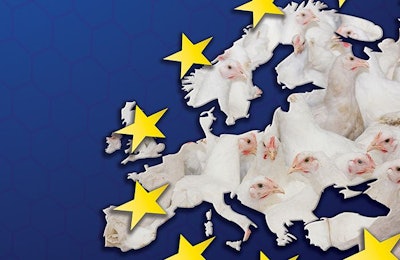
European poultry meat producers can look forward to a decade of further expansion, but at significantly lower levels than the growth enjoyed over the past 10 years.
In its "EU Agricultural Outlook for Markets and Income 2018-2030," the European Commission says that, while there remain opportunities for Europe’s chicken meat producers at home and overseas, domestically overall meat consumption is expected to decline, and internationally competition will intensify.
The outlook suggests a period of relatively stable feed prices to 2030, strong domestic and world demand for poultry meat, and it forecasts that the European Union’s poultry meat production will reach 15.5 million metric tons by 2030.
Output last year was up on 2017, with the industry buoyed by strong prices. At 14.2 million metric tons, the sector expanded by a little less than 2.2 percent, in strong contrast to the 1 percent contraction recorded the year before due to outbreaks of avian influenza, and closer to the average 2.5 percent expansion recorded over the preceding decade. The year started particularly strongly, with all member states -- with the exception of Italy -- registering growing production over the first six months.
This average rate of expansion is not, however, expected to be sustained over the decade ahead.

Although production, consumption and exports are all forecast to grow over the next decade, European poultry producers will not enjoy the same levels of growth recorded over the past 10 years. (European Commission)
The commission believes that the rate of expansion will fall to an annual average of 0.3 percent over coming years, meaning that, by 2030, Europe’s chicken meat output will stand at 15.5 million metric tons.
Some member states will benefit more from sustained demand for chicken meat than others, and growth will be far from even across the bloc.
The strongest performance will continue to be recorded in the 13 newer EU members, and this higher level of expansion, albeit at a lower rate than in previous years, will be attributable largely to sustained productivity investments and gains in Hungary, Poland and Romania, all three of which had poultry sectors that were among the best performing last year.
While the poultry sector may be expecting slower growth rates, it will, nevertheless, outperform producers of some competitor proteins gaining market from them as the EU’s total meat output is forecast to be static over the period.
The overall share in meat production will change, driven by shifting consumer preferences, export potential and profitability.
Europe’s poultry meat consumption
The period of growing meat consumption within Europe is now thought to be coming to an end and, by 2030, per capita meat consumption is expected to have declined slightly by 700 grams.
This change has been attributed to a variety of factors including social and ethical concerns, environmental and climate worries, and an aging population.
But this decline in meat consumption will not be felt evenly across protein types, and poultry will gain some ground against competitor meats.
At 24 kilograms per person per year, per capita poultry meat consumption is expected to increase slightly, growing on average by 0.2 percent each year to 24.8 kilograms by 2030.
International poultry trade
EU exports of poultry meat are thought to have been almost 2.5 percent higher at the end of 2018. This growth is set to continue, but again at a slower rate.
The bloc’s exports fell by 1 percent in 2017 on the back of trade bans due to avian influenza, but are now expected to continue growing by an average of 1.4 percent per year, reaching 1.9 million metric tons by 2030.
The product mix in the bloc’s exports is changing. The commission notes that exporters have faced increased competition in international markets, particularly for whole birds and most notably from Brazilian producers.
Europe’s whole bird exports have been declining for several years. For example, in 2017, frozen chickens accounted for only half the volume of exports recorded five years earlier, and made up only 20 percent of 2017’s exports.
By volume, Europe’s top three export markets are Ghana, Ukraine and the Philippines, whereas by value, Switzerland is the most important market for European product.
Cuts now account for more of the chicken meat exported from Europe, for example wings to Hong Kong or halves and quarters to Africa, and overseas markets will remain important to producers given lower levels of growth at home.
Europe has imported notably less chicken meat over recent years, with imports contracting by 10 percent in 2017 and by almost 3 percent last year.
This decline was due primarily to restrictions on Brazilian imports due to sanitary concerns. At the end of July 2018, imports from Brazil were 38 percent lower year on year.
Some Brazilian product was substituted by supplies from Ukraine, Thailand and Chile, however, once Brazil’s issues are resolved, imports levels are expected to return to an upward trend, reaching 1 million metric tons by 2030.

To learn more about Europe’s largest poultry companies, visit the World’s Top Poultry Companies database: www.WATTAgNet.com/worldtoppoultry.html
EU poultry production forecast positive over next decade


















